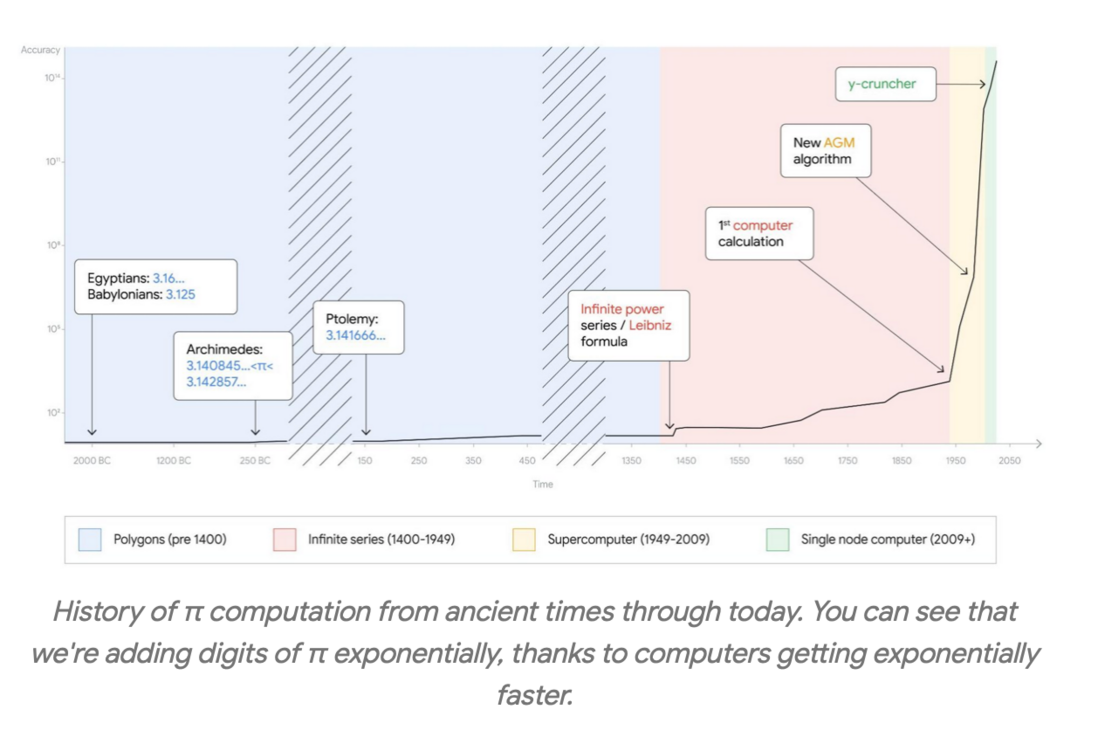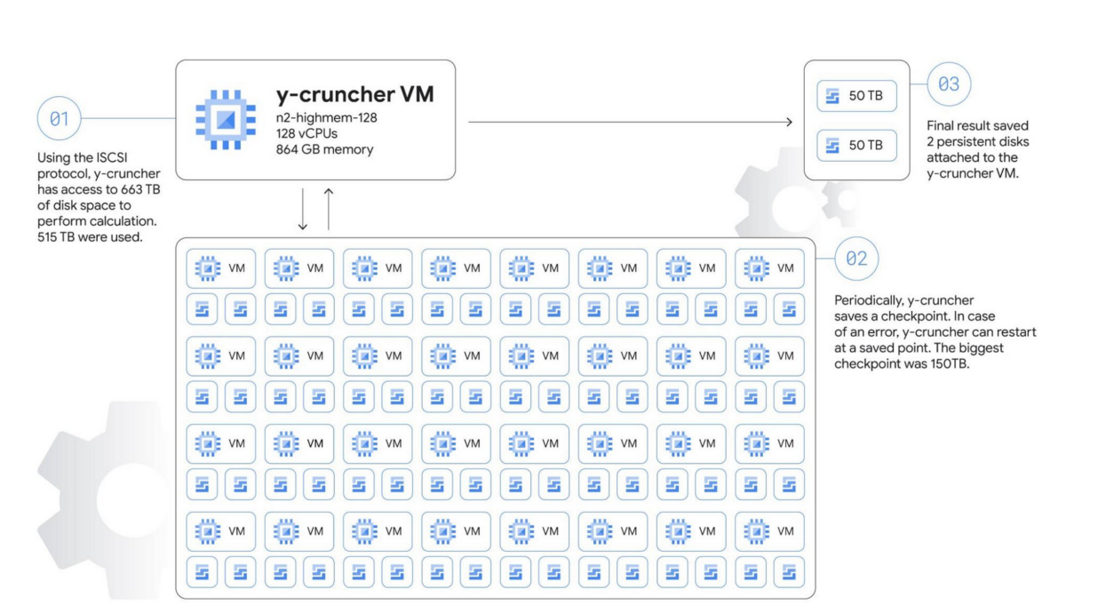On June 8, Google Cloud's official blog announced a new record - the 100 trillionth digit after the decimal point of the pi "π" has been calculated through Google Cloud! (The last 100 digits of this calculation are attached at the end of the article)
I believe that everyone knows the pi "π" in elementary school, but at that time we only knew that the mathematical constant of this infinite loop is approximately equal to 3.14 or 3.1415926, which can be recited to a few decimal places at most. As everyone knows, in recent years, this irrational number has been calculated more precisely by scientists with the development of technology.
It is understood that as early as 2019, Google calculated the 31.4 trillionth digit after the decimal point of "π", which broke the world record that year. Then, in 2021, scientists at the University of Applied Sciences of the Grisons (UAS Grisons) in Switzerland calculated another 31.4 trillion constants, bringing the total to 62.8 trillion decimal places.
This is the second record-breaking calculation of the mathematical constant "π" by Google Cloud Computing, and the number has tripled in just three years. This achievement also verifies the rapid development of Google Cloud infrastructure.
The underlying technology behind Google Cloud computing
According to Google, the underlying technology behind all of this is the computing engine - Google Cloud's secure and customizable computing services, as well as several recent additions and improvements: including N2 cloud computing engine series, virtual NIC @ 100 Gbps egress bandwidth, and balanced Persistent Disks.
The following is an overview of Google Cloud Computing's work on the 100 trillionth digit after the "π" decimal point:
Program: y-cruncher v0.7.8, Author: Alexander J.Yee
Algorithm: Chudnovsky Algorithm Compute Node: n2-highmem-128 with 128 VCPUs and 864 GB RAM
Start: 2021 Thu, Oct 14 04:45:44 UTC
Ends: Monday to March 21st 04:16:52 2022 UTC
Total runtime: 157 days, 23 hours, 31 minutes, 7.651 seconds Total storage size: 663 TB available, 515 TB used
From the past to the present, we can see that due to the faster and faster development of computer speed, the number of digits after the decimal point of "π" is also increasing exponentially.
- Architecture
Since the computation of "π" is a computationally, storage, and network intensive task, it presents challenges in the way the computing engine environment is configured.
Google Cloud Compute Engine provides machine types that support compute and I/O intensive workloads, choosing n2-highmem-128 (Intel Xeon, 128 VCPU and 864 GB RAM) the amount of available memory and network bandwidth as the two most important factors To meet the needs of high-performance CPU, large memory and 100 Gbps egress bandwidth.
In terms of storage, Google estimates the temporary storage size required for computing to be around 554 TB, and designed a cluster of one compute node and 32 storage nodes for a total of 64 iSCSI block storage targets.
The primary compute node is an n2-highmem-128 computer running Debian Linux 11 with 128 VCPUs and 864 GB of memory, 100 Gbps egress bandwidth support, and a network-based shared storage architecture.
Each storage server is an n2-highcpu-16 machine configured with two 10359 GB partition-balanced persistent disks. The N2 machine series offers a balanced price/performance ratio, with 32 Gbps of network bandwidth when configured with 16 VCPUs, and the option to use the latest Intel Ice Lake CPU platforms, making it a good choice for high-performance storage servers.
- Automation Solutions
Google Cloud uses Terraform to set up and manage the cluster, and two shell scripts are written to automate key tasks. The Terraform script creates a guest OS (guest) policy to help ensure the required packages are automatically installed. The guest OS operating system installs Part of the process is handled by the startup script, which recreates the entire cluster with just a few commands.
- 100 Gbps network
As early as 2019, when Google calculated the 31.4 trillionth decimal place of "π", its cloud computing machine export throughput was only 16 Gbps. This time, the n2-highmem-128 model supports up to 100 Gbps of egress throughput, which means a 600 percent increase in bandwidth in just three years.
This time, the network driver was also changed from virtio to the new Google Virtual NIC (gVNIC). gVNIC is a new device driver that is tightly integrated with Google's Andromeda virtual networking stack to help achieve higher throughput and lower latency, which is also a requirement for 100 Gbps egress bandwidth.
- storage design
Persistent Disk (PD) is a persistent high-performance storage option for Compute Engine VMs, and this time Google chose to use balanced PD - a new type of persistent disk that provides up to 1200 MB/s read and write throughput and 15-80k IOPS, the cost is about 60% of SSD PD. This storage profile is the best choice for y-cruncher, which requires high throughput and moderate IOPS.
Overview
All of these fine-tuning and benchmarking together have allowed Google to calculate the 100 trillionth digit after the "pi" decimal point this time.
After the calculation was completed, Google also verified the final number with another algorithm (Bailey–Borwein–Plouffe formula), and the formula was finally verified successfully.
The following are the last 100 digits of the calculation result of the 100th trillion digits after the decimal point of "π" by Google Cloud Computing:
4658718895 1242883556 4671544483 9873493812 1206904813
2656719174 5255431487 2142102057 7077336434 3095295560
If you want to see the entire sequence of numbers in this calculation, you can log on to Google Cloud Computing's demo site to view it.
Reference link: https://cloud.google.com/blog/products/compute/calculating-100-trillion-digits-of-pi-on-google-cloud




**粗体** _斜体_ [链接](http://example.com) `代码` - 列表 > 引用。你还可以使用@来通知其他用户。